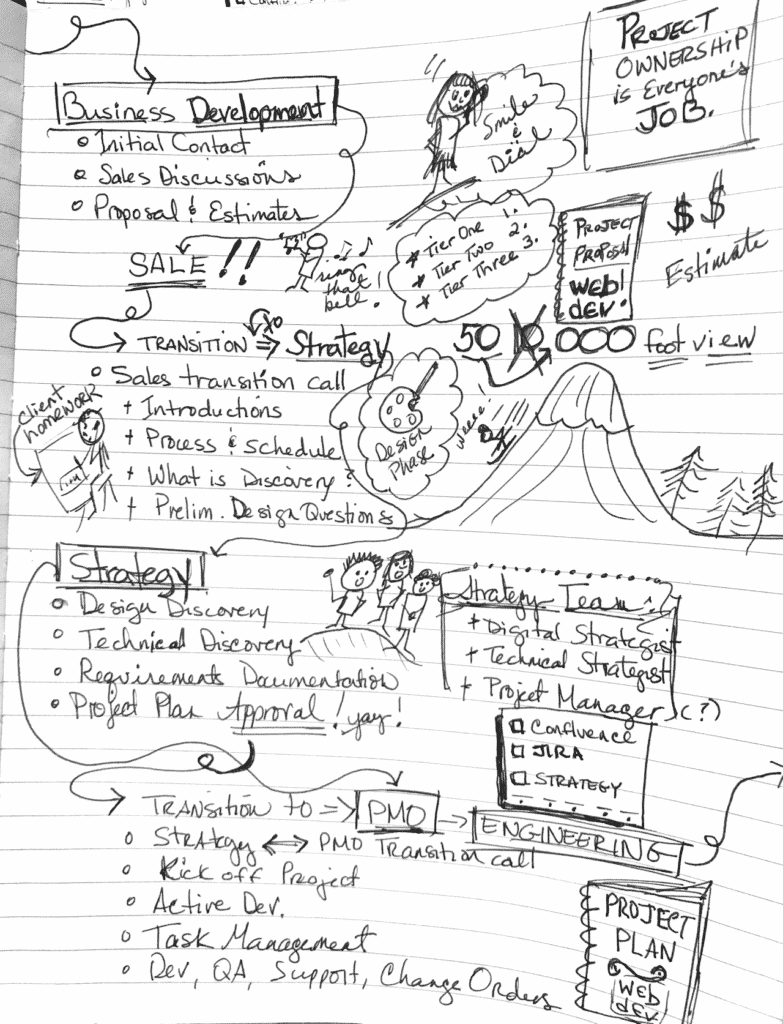I clean. I bake. I knit. I draw. I play a few rounds of Team Deathmatch on COD. ANYTHING but what I am supposed to be doing. For years, I’ve called this procrastination and have mentally beat myself up over it. Somehow, though, I always pull it off … whatever IT is. I’ve always prided myself on my ability to pull through. It happens when I’m writing a book, or when I have a large process to wrangle at work or a highly complex project for clients with hundreds of moving parts. I hit the deadline and I deliver – – but it’s a painful process, because of procrastination.
Or so I thought.
Having matured, both personally and professionally, and I understand now that this is just my process. It’s not procrastination at all. For all of those hours, days or weeks that I’ve spent doing anything else BUT the task at hand, I realize now that what I am really doing is developing a plan in my head. Going through the workflow, the process or the steps that I need to do in order to reach the finish line. Once I have sorted it out and broken it all into digestible pieces in my brain and have finally reached a good starting point – – the brain dump begins. I have got brain dumping down to a science!
That is not to say that my process doesn’t cause anxiety – because it does! Depending on how long this process takes (a day, a week, more…) the anxiety builds. Mainly because I know that whatever it is is attached to a deadline that I have to meet. For my books – I have chapter deadlines: 25% of the book due in the first month, 25% in the second and so on. There are dates and people on the other end who are expecting me to deliver on time. Those deadlines approach like a dark cloud in the horizon and even though I know that I have the power to sit down, RIGHT NOW, and get it all done – – my brain is not done processing it’s a plan.
I told my husband the other day “It’s like my brain is constipated and just needs to take a dump!”
He told me that I’m always like this – – that I’m a process person. It’s not procrastination, it’s processing.
But, that doesn’t make it any less painful and anxiety-ridden! At work, you’ll find me saying things like “I love the process!” or “Process is my passion!” – but, while that may be true to some degree, I think it’s just the way I’m built – I need process, for whatever reason….and, apparently, it needs me too – because it always seems to find me.
I think the nurse in me will never completely go away, no matter how many years I’ve been absent from the medical field. You start with the most critical piece that needs to get resolved and the rest of the smaller pieces fall into place. Take CPR, for instance. One of the first things you learn as a first responder is the ABC’s of CPR.
- Airway – always check the airway first, because if the patient’s airway is not clear, they cannot breathe.
Clear the airway. - Breathing – once it’s established that the airway is clear, make sure the patient is breathing – oxygen is good.
Perform mouth to mouth. - Circulation – ensure the patient has a heart rhythm to circulate all that good oxygen that is vital for life.
Perform chest compressions.
Always in that order, because it is about priority – – what is the first priority? Once you know that, you can work from there.
Over the past two weeks, at work, I’ve been faced with a complex project for a client. I am not going to develop the site myself – but what I do need to do is develop a strategy and plan so that I can communicate that plan to our engineers, and to the client. This is a large project with multiple user types, data sources, API integrations and a complex workflow that syncs data at very specific points in the process, and transfers data responsibility back and forth between multiple user types during specific steps along the way.
I began formulating a plan in my head about how all of that data was going to get pulled in from multiple data sources and where that data would be stored in order to begin manipulating that data to fulfill the requirements..blah blah blah. Sounds pretty exciting, I know. BUT! What did I find myself doing over the past several days instead of documenting a plan?
I mopped my kitchen floor. I did dishes. I baked a cake. I cleaned the bathroom. I took a walk. I did every single thing BUT that thing.
Not really, though. While I was doing those tasks – I was also hard at work sorting through the plan and developing my own ABC’s of this complex build. And yes, my brain was constipated for about a week and a half until it FINALLY took a dump today in the form of a Swimlane Flowchart (a diagram that visually distinguishes job sharing and responsibilities for sub-processes of a business process) accompanied by a few WordPress Admin screen wireframes. Boring stuff, really – but I was really excited to finally have things sorted out. It took me 4 hours to dump this project out of my brain – – now I have a plan that I can present to engineering, to give them the opportunity to help me refine it, and a plan to present to the client to explain the work in a way that will make sense to them, as well – and justify the number of hours and cost that I am proposing are needed for their MVP, and beyond. 1 1/2 weeks of brain constipation – – 4 hours of brain dumping. I’m excited that my brain finally took a dump and now the pressure is gone and relief is here.
So, how to take an effective brain dump?
I can’t say that I fully recommend mopping your kitchen floor (…. but if you wanted to come mop mine, we should talk). In the case of a complex build like this – I recommend starting at the beginning. One of my very favorite quotes in life is from Alice in Wonderland:
Begin at the beginning, and go on ’til you get to the end, then stop.
Lewis Caroll; Alice in Wonderland
Best quote ever….for pretty much everything in life, I think.
For this particular build – it starts with the data. Answer the questions of:
- Where does the data currently live
- What options do I have to access the data
- What methods can I use to retrieve the data
- What the hell am I going to do with the data once I have it in my dirty little paws?
If I do not solve for the data first – – nothing else falls into place. In this case – the data is my airway. Begin at the beginning…. solve those first big steps and a plan begins to take place, things begin to take shape and pretty soon, relief.
Here are some methods that I find most effective when faced with some insurmountable task that contains a million different pieces, and I would love if you would share yours. My mind is always open to different ways of getting from the beginning to the end.
Pen and paper
Listen, I’m old – which means I’m old-school. You can have my ink pen when you can pry it from my cold dead hands. Hey, if typing works better for you – go for it. Whichever way you do it – just start writing the relevant words that pertain to the process you’re trying to solve for. They don’t have to be in any particular order. If you’re having a hard time finding the starting point for whatever your task is – just start writing. One word is fine – that’s a good starting point because one word leads to two, then three and pretty soon you have a list of things that need to get solved for in order to get yourself to the end of the larger task at hand.
For me, and this project, it went something like: Data, Salesforce API, WordPress API, Custom Post Types, Taxonomies, Custom Meta, Sync, Two-way Sync, User roles, Access, Capabilities, Workflow, Data Cache, Capture Changes, Frontend Editing, Gutenberg…and on and on until I had a veritable word cloud of relevant words that had no particular order… but were there, on paper. Once a word has been committed to paper, it’s there for good – in ink, so you can let go of it (for now) and move on to the next, and the next until you have no more words that describe the larger task. Once you have your words, you can begin organizing them into priority – and categorizing them so they make sense and things start taking shape
Sketchnotes
I am a visual learner, so it makes sense that I am also a visual planner. Visuals help me make sense of things. So it also makes sense that I am a doodler. I doodle a lot. In fact, at work, I’ve presented my doodles as ideas for a process, workflow in presentation form. For Christmas this year, Jodie (our Dir. of Business Development at WebDevStudios) gifted me with the most thoughtful gift from the Brooklyn Library. They are doing The Sketchbook Project and Jodie sent me one for entry. Basically you get a book and you fill it with sketches – – drawings, writings, collages, cuttings – anything – you fill it up and mail it in by August 2020 and you become an official Sketchbook Artist at the Brooklyn Library. How cool!
Point is, I love to doodle. I recently started getting into sketching and purchased a few books and resources on the topic to refine my process (check out Mike Rohde’s The Sketchnote Handbook and The Sketchnote Workbook – these are GREAT resources, plus Mike is a fellow Packer fan!)
Refining my sketchnote process and abilities has really helped me dump my brain onto paper. It’s a lot like the brain dump of words, but I combine them with sketches that help illustrate what is in my head and allows me to create a sense of order by grouping thoughts and words together with illustrations and doodles. Jodie gave me that gift for Christmas because she gets me – I haven’t done a doodle for her lately, I should probably get right on that!
For anyone who runs project operations in an agency or freelance business, the concepts in this brain dump sketchnote shouldn’t look too foreign – just don’t judge my doodles! This is an oldie, but a goodie .. one that Jodie will appreciate:

Flowcharts and Spreadsheets
I never met a flow chart I did not like… or love. The same goes for spreadsheets. Both of these methods of organizing a process, a workflow, business requirements get me right my beating heart. I use LucidChart a lot for spinning up a quick flowchart or diagram when I need one. For spreadsheets, nothing beats good ol’ trusty, dusty Excel – or Google Spreadsheets when you need to collaborate. Once you have your words and have organized them into priorities and categorized them – using a tool like a flowchart or a spreadsheet to illustrate and organize the data to drill it down will help get you closer to the end. I particularly love Flowcharts because they give me a good way to work out conditionals (if this, then that, and so on) by building out decision trees.
This has been a really long-winded way of saying what the Hustle Startup has said in 8 short points:
How Do You Brain Dump?
- Open up a Google Doc (or use pen and paper).
- Set up one bullet point to start with.
- Set a Timer If You Have Limited Time.
- Start Writing.. Everything That Comes to Mind.
- Go For a Walk.
- Add to the Original List.
- Categorize Your Brain Dump List.
- Break Down Big Projects Into Tasks.
So, I’m long-winded. Maybe I just needed to dump my brain – – that is what a blog is for, after all, eh?

